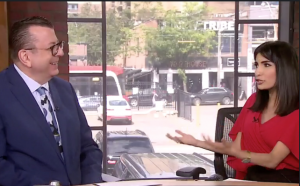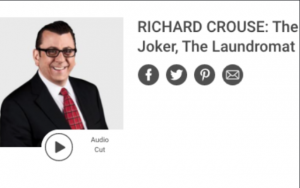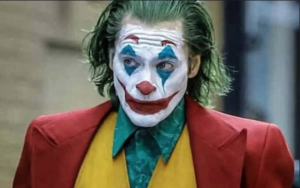Posts Tagged ‘the Joker’
Friday, October 4th, 2019
Watch the whole thing HERE
Tags: Arthur Fleck , DC Comics , Frances Conroy , Joaquin Phoenix , John Vennavally-Rao , Joker , psychological thriller , Robert De Niro , Scott Silver , the Joker , Todd Phillips , Zazie Beetz Film Review | Comments Off on CTV National NEWS: RICHARD ON why the film “Joker” has police concerned.
Friday, October 4th, 2019
Watch the whole thing HERE
Tags: Alan Latham , Alice Lowe , Antonio Banderas , Art Hindle , Arthur Fleck , Bill Nighy , biographical comedy-drama , Carl Hunter , comedy-drama , Corey Stanton , David Schwimmer , DC Comics , Frances Conroy , Frank Cottrell Boyce , Gary Oldman , Hurricane Films , James Cromwell , Jeffrey Wright , Jenny Agutter , Jeremy Ferdman , Joaquin Phoenix , Joker , Matthias Schoenaerts , Meryl Streep , psychological thriller , Robbery , Robert De Niro , Roy Boulter , Sam Riley , Scott Silver , Scott Z. Burns , Sera-Lys McArthur , Sharon Stone , Sol Papadopoulos , Sometimes Always Never , Steven Soderbergh , the Joker , The Laundromat , Tim McInnerny , Todd Phillips , Zazie Beetz Film Review | Comments Off on RICHARD’S WEEKEND MOVIE REVIEWS FROM CP24! FRIDAY OCTOBER 04, 2019.
Friday, October 4th, 2019
Watch the whole thing HERE
Tags: Arthur Fleck , DC Comics , Frances Conroy , Joaquin Phoenix , Joker , psychological thriller , Robert De Niro , Scott Silver , the Joker , Todd Phillips , Zazie Beetz CP24 | Comments Off on CP24 LIVE AT NOON: RICHARD ON THE CONTROVERSY SURROUNDING “JOKER.”
Friday, October 4th, 2019
Watch the whole thing HERE
Tags: Arthur Fleck , CTV News at Noon , DC Comics , Frances Conroy , Joaquin Phoenix , Joker , psychological thriller , Robert De Niro , Scott Silver , the Joker , Todd Phillips , Zazie Beetz Uncategorized | Comments Off on CTV NEWS AT NOON: RICHARD ON THE CONTROVERSY SURROUNDING “JOKER.”
Friday, October 4th, 2019
Watch the whole thing HERE
Tags: Alan Latham , Alice Lowe , Art Hindle , Arthur Fleck , Bill Nighy , Carl Hunter , comedy-drama , Corey Stanton , DC Comics , Frances Conroy , Frank Cottrell Boyce , Hurricane Films , Jenny Agutter , Jeremy Ferdman , Joaquin Phoenix , Joker , psychological thriller , Robbery , Robert De Niro , Roy Boulter , Sam Riley , Scott Silver , Sera-Lys McArthur , Sol Papadopoulos , Sometimes Always Never , the Joker , Tim McInnerny , Todd Phillips , Zazie Beetz Film Review | Comments Off on CTVNEWS.CA: THE CROUSE REVIEW ON “JOKER” “ROBBERY” AND MORE!
Friday, October 4th, 2019
Watch the whole thing HERE
Tags: Alan Latham , Alice Lowe , Antonio Banderas , Art Hindle , Arthur Fleck , Bill Nighy , biographical comedy-drama , Carl Hunter , comedy-drama , Corey Stanton , David Schwimmer , DC Comics , Frances Conroy , Frank Cottrell Boyce , Gary Oldman , Hurricane Films , James Cromwell , Jeffrey Wright , Jenny Agutter , Jeremy Ferdman , Joaquin Phoenix , Joker , Matthias Schoenaerts , Meryl Streep , psychological thriller , Robbery , Robert De Niro , Roy Boulter , Sam Riley , Scott Silver , Scott Z. Burns , Sera-Lys McArthur , Sharon Stone , Sol Papadopoulos , Sometimes Always Never , Steven Soderbergh , the Joker , The Laundromat , Tim McInnerny , Todd Phillips , Zazie Beetz Film Review | Comments Off on RICHARD’S CTV NEWSCHANNEL WEEKEND MOVIE REVIEWS FOR OCT 04.
Friday, October 4th, 2019
Listen to the whole thing HERE
Tags: Alan Latham , Alice Lowe , Antonio Banderas , Art Hindle , Arthur Fleck , Bill Nighy , biographical comedy-drama , Carl Hunter , comedy-drama , Corey Stanton , David Schwimmer , DC Comics , Frances Conroy , Frank Cottrell Boyce , Gary Oldman , Hurricane Films , James Cromwell , Jeffrey Wright , Jenny Agutter , Jeremy Ferdman , Joaquin Phoenix , Joker , Matthias Schoenaerts , Meryl Streep , psychological thriller , Robbery , Robert De Niro , Roy Boulter , Sam Riley , Scott Silver , Scott Z. Burns , Sera-Lys McArthur , Sharon Stone , Sol Papadopoulos , Sometimes Always Never , Steven Soderbergh , the Joker , The Laundromat , Tim McInnerny , Todd Phillips , Zazie Beetz Film Review | Comments Off on CFRA IN OTTAWA: THE BILL CARROLL MORNING SHOW MOVIE REVIEWS!
Thursday, October 3rd, 2019
Listen to the whole thing HERE
Tags: Antonio Banderas , Arthur Fleck , biographical comedy-drama , David Schwimmer , DC Comics , Frances Conroy , Gary Oldman , James Cromwell , Jeffrey Wright , Joaquin Phoenix , Joker , Matthias Schoenaerts , Meryl Streep , psychological thriller , Robert De Niro , Scott Silver , Scott Z. Burns , Sharon Stone , Steven Soderbergh , the Joker , The Laundromat , Todd Phillips , Zazie Beetz Film Review | Comments Off on CJAD IN MONTREAL: THE ANDREW CARTER SHOW WITH RICHARD CROUSE ON MOVIES!
Wednesday, October 2nd, 2019
Listen to the whole thing HERE
Tags: Arthur Fleck , DC Comics , Frances Conroy , Joaquin Phoenix , Joker , psychological thriller , Robert De Niro , Scott Silver , the Joker , Todd Phillips , Zazie Beetz Richard Sez | Comments Off on CJAD: ARE MOVIE THEATRES AND POLICE ON THE ALERT FOR VIOLENT ATTACKS?
 Richard in a CTV National News report by John Vennavally-Rao on why the film “Joker” has police in several cities step up security at theatres over concerns for its content.
Richard in a CTV National News report by John Vennavally-Rao on why the film “Joker” has police in several cities step up security at theatres over concerns for its content.







